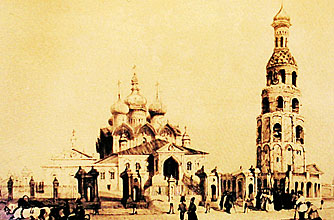The Annunciation Cathedral of Kazan Kremlin
 | |
The history of The Annunciation cathedral as archpriest A.Yablokov wrote about those years dates to time when «in the Kazan Tatar land Russian civilization just began to settle down and for the first time light of Christianity started to shine". Laying of wooden church on place of the future cathedral refer to acts of tsar Ivan IV who on October 4, 1552 "solemnly, accompanied by brilliant retinue of boyars and generals entered half-demolished walls of the Kazan fortress». Having stopped at northern part of the Kremlin, nearby Khan palace and mosque, the tzar «indicated the place for construction of cathedral church in honour of The Annunciation of the Most Holy the Virgin, he himself put the foundation, set up a life-giving cross on the place intended for throne». The cathedral church cut down in three days was consecrated on October 6, 1552 also at the presence of tsar.
The wooden church in the name of Annunciation has become a temple Sanctifier's chair when on July 28, 1555 here archbishop Gury arrived to head newly founded Kazan diocese.
The Annunciation temple in the Kazan Kremlin became the center of religious - educational life and a stronghold of spreading Christianity in territory.
 | |
During 16-18th centuries the Cathedral suffered many times from fire. The most devastating fires occurred in 1596, 1672, 1694, 1742, 1749, 1757. Renewals and repairs, expansions and changes of architectural details (extension of side altars, church porches, fraters, replacement of decorative cupolas) made after fires corresponded to likes in church construction of its time and were more or less organic to the forms of initial three apside cross-cupola temple. Archpriests of Kazan not once had to take much trouble for striving to establish anew an appropriate iconostasis, renewal of old mural which fragments are being kept up this day. The most destructive was a fire of 1815 when together with all city the cathedral had burnt out and its former magnificence was being restored for a long time. Exactly during restoration and expansion of the cathedral in 1841 an extensive fraters was built, it extended the initial temple to the West and strongly changed external outlook of the Cathedral. However, the works carried out in 19th century promoted adorn¬ment of the cathedral: high iconostasis resembling ancient famous iconostasis of Sanctifier Gury times» appeared (not preserved) but the main thing - in 1870 interior of the cathedral was painted by sacred and church images located by tiers on walls, vaults and columns. These paintings restored last years are an original ornament of the cathedral.
 | |
 | |
In the beginning of 20th century The Annunciation Cathedral lost much from its magnificence. The ensemble of the buildings arisen around of old cathedral within several centuries was destroyed in 1920s: the multi-tier stone bell tower with a temple under belfry was demolished, decorative cupolas of drums the western porch and stone fencing disassembled. Little has reached up to now for centuries gathered treasures of a vestry - clerical garments of precious sewing, embroidered covers and banners, icons and on throne crosses with relics, gold and silver church vessels.
In 1977 restoration of cathedral started: external walls, floors were under repair, cupolas and crosses were restored. In the cathedral down to 1996 there were storehouses of republican archive, and restoration of interiors started only in 1997.
From 1995 the complex of the Annunciation cathedral by the decree of RT President Mintimer Sharipovich Shaimiev was transferred in management of the State history-architectural museum - reserve «The Kazan Kremlin». Scientific restoration of the cathedral conducted last years is directed on restoration of its historical shape. After long years of oblivion the cathedral will accept believers, the church service will begin to sound in it again.
Materials provided by “Master” LTD